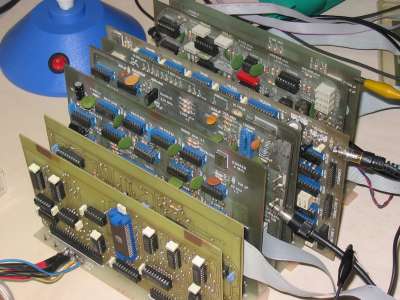
THE HARDWARE
The Nuova Elettronica Z80 computer is composed by different cards that plug into a proprietary bus card.
Here you will find descriptions of all cards. If you would like to build the computer, I suggest to read all magazine articles in the articles section, without forgetting all errata corrige.
NOTE: binary and source files of various eproms are available in the software section. If you are serching for schematics I suggest you to view schematics section, that contains alla schematics with corrected typographics errors.
This is the list of cards and kits published on the magazine:
Published on magazine number: 68
Errata corrige on magazine number: 71
Printed circuit (gerber files): see printed circuit board section
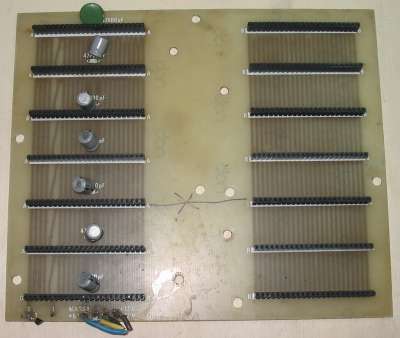 The 7 cards BUS - LX.381 |
|
Other LX.381/B images:
|
It's a card where there are some 24 pin female connectors.
Two bus cards were available, one for 7 cards code LX.381, and the other one for 10 cards code LX.381/B.
All connections on the bus are in parallel, with the exception of one line that is "crossed" between two connections. Theoretically this connection make a priority on the signal depending on where it's plugged the card on the bus: cards at the beginning of the bus have priority signal over back cards.
But in reality this characteristic has never been used because all cards have a bridge connection on these two lines, and they are never used.
In the next table you'll find all bus connections. Always use this table whey you read schematics, because sometimes some connection on schematics is wrong (pin numbers are swapped). The asterisk (*) means a negate signal (active low):
| "A" CONNECTOR (on the left) | "B" CONNECTOR (on the right) | ||||
|---|---|---|---|---|---|
| PIN | SIGNAL | DESCRIPTION | PIN | SIGNAL | DESCRIPTION |
| 1 | S | 10V AC from power supply | 1 | A0 | Address bus |
| 2 | ENH | if low it disables all memory expansions to give any data | 2 | A1 | |
| 3 | *HLT | halt | 3 | A2 | |
| 4 | *RFH | refresh | 4 | A3 | |
| 5 | *PH | high priority | 5 | A4 | |
| 6 | *PL | low priority | 6 | A5 | |
| 7 | *INT | maskable interrupt | 7 | A6 | |
| 8 | *WAIT | wait | 8 | A7 | |
| 9 | *NMI | non maskable interrupt | 9 | A8 | |
| 10 | *BUSACQ | bus acknowledge | 10 | A9 | |
| 11 | *BUSREQ | bus request | 11 | A10 | |
| 12 | +5V | power line | 12 | A11 | |
| 13 | +5V | power line | 13 | A12 | |
| 14 | GND | ground line | 14 | A13 | |
| 15 | GND | ground line | 15 | A14 | |
| 16 | +12V | power line | 16 | A15 | |
| 17 | -12V | power line | 17 | D7 | Data bus D0 = LSB D7 = MSB |
| 18 | *RESET | reset | 18 | D6 | |
| 19 | *RD | read | 19 | D5 | |
| 20 | *WR | write | 20 | D4 | |
| 21 | *M1 | fetch | 21 | D3 | |
| 22 | *PR | peripheral request | 22 | D2 | |
| 23 | CLOCK | clock | 23 | D1 | |
| 24 | *MR | memory request | 24 | D0 | |
The bus connectors are probably one of the few weak points of the entire machine. Infact with time they tend to oxidize themselves by creating bad contacts, and also being the plug the only mechanical anchor, the cards tend to oscillate everytime the machine is moving, straining the connectors that became weak and have no more a properly contact.
In my computer I made an extension to the bus card and I put vertical slips to keep cards in place, as explained in the add-ons and researches section.
Published on magazine number: 69
Printed circuit (gerber files): see printed circuit board section
It's a linear stabilized power supply (not a switching one) that gives the following voltages:
The -12 volt supply is generated earlier than +12 and +5 (or better, other supply voltages are delayed regarding -12 volt), to avoid damaging 2708 Eprom that is on the CPU card.
Published on magazine number: 68
Schematics on magazine number: 69
Printed circuit (gerber files): see printed circuit board section
This card contains the Z80 CPU, the firmware Eprom, 1 KBytes of RAM and the reset circuit.
The Eprom, the RAM and the reset circuit are used only if the computer is in a configuration with the hexadecimal keyboard only: if any memory expansion or floppy interface are used they need to be removed, and on the CPU card it remains the Z80 and surrounding integrated circuits only.
The 2708 Eprom contains the firmware with hexadecimal keyboard monitor program, while the ram need to be used only if there are no memory expansion cards.
On this card there is also a power stabilizer made with a zener diode that's used to generate -5 volt needed to the eprom, starting from -12 volt from the power supply.
A particular note needs to be done about the reset circuit.
The firmware contained in the 2708 Eprom starts from address 0x8000 (hexadecimal). Due to the fact that at reset the Z80 starts reading the program from address 0x0000, engineers needed to find a method to point the Z80 to address 0x8000, and the reset circuit is dedicated to this purpose.
So, chips dedicated to this reset circuit read CPU M1 signals (instruction fetch), and for the first two impulses they force bit 15 to logic 1 on the address bus, enabling the 2708 eprom to return data.
The first three locations of 2708 eprom contain bytes C3 AB 81, that is the instruction JP 0x81AB. So the CPU as first instruction make a jump to address 0x81AB, that is a location in the same eprom.
So, while "believing" to read location 0x0000, CPU makes a jump to location 0x81AB. At this point, starting from the second M1 impulse, the reset circuit stop forcing the bit 15 to 1, leaving the CPU to continue operations normally from location 0x81AB.
HEXADECIMAL KEYBOARD AND DISPLAY INTERFACE - LX.383
Published on magazine number: 68
Schematics on magazine number: 69
Errata corrige: see text below
Printed circuit (gerber files): see printed circuit board section
This card is the interface that lets the card containing the hexadecimal keyboard and display to connect to the BUS.
The chips make decoding of I/O addresses and generate keyboard scan signals and display refresh signals (displays are multiplexed). Both keyboard and display are seen as I/O peripherals.
The card is connected to the hexadecimal keyboard with a 20 pin flat cable.
ATTENTION: this card schematic is wrong (and there is no errata corrige). The two chips IC6 and IC7 (both 74LS32) are OR ports, and not NOR ports as written on schematic.
HEXADECIMAL KEYBOARD AND DISPLAY - LX.384
Published on magazine number: 68
Schematics on magazine number: 69
Printed circuit (gerber files): see printed circuit board section
This card contains the hexadecimal keyboard and 8 seven segments displays.
It needs to be connected to LX.383 interface using a 20 pin flat cable.
The red button is the CPU RESET, while the black button is the CONTROL button that, pushed together with one blue button when the card is under control of the monitor program, enables additional functions (for example showing memory content, showing CPU registers, etc.)
Published on magazine number: 70
Errata corrige on magazine number: 71
This card connects to two common audio tape recorders to load and save data and programs.
The card has two audio inputs, two audio outputs, two REM controls to start and stop tapes motor (they are two relais), and one led diode that power on during tape read/write.
The card uses an UART type CDP1854. Read and write speed can be setup by way of jumpers at 300, 600 or 1200 baud, even if the magazine suggests to setup it at 300 baud only, due to low quality of that old tape recorders. Unfortunately to reconfigure it you need to recalibrate the two trimmers on the card (to be done preferably using an oscilloscope), so it's not possible to change speed easily.
Data are saved on tape using Kansas Standard format, that as explained on the magazine uses 1200 Hz and 2400 Hz signals (for 300 bps speed). To be precise to encode a binary 0 there are 4 periods at 1200 Hz, while to encode a binary 1 there are 8 periods at 2400 Hz.
For every data bytes these data bits are written on tape:
- 1 start bit at 0 (that is 4 periods at 1200 Hz)
- 8 data bits, encoded as explained previously, starting from the less meaningful bit to the most one
- 1 parity bit (even) computed on data bits: parity bit is 0 if the number of 1 of 8 data bits is even, it's 1 if the number of 1 of 8 data bits is odd
- 2 stop bits at 1 (that is 16 periods at 2400 Hz).
For higher speeds it's sufficient to double frequencies. So:
- for 300 bps 0 bits are at 1200 Hz, 1 bits are at 2400 Hz
- for 600 bps 0 bits are at 2400 Hz, 1 bits are at 4800 Hz
- for 1200 bps 0 bits are at 4800 Hz, 1 bits are at 9600 Hz.
By using the hexadecimal monitor it's possible to save or load 1 Kbyte at time only, and the first two saved bytes are the memory address of the first following byte (the first byte is the most meaningful address byte, then there is the less meaningful one).
This card can be used with hexadecimal monitor, with 5.5K tape basic, and with 16K Eprom basic card.
It's not supported by NE-DOS and by floppy Basic, even if obviously it's possible to write some assembler routines to use it (or use that ones already contained in the hexadecimal keyboard monitor, after doing the patches that let you use all firmware types at the same time as explained into add-ons and researches section).
8 KBYTES MEMORY EXPANSION - LX.386
Published on magazine number: 70
Errata corrige on magazine number: 71 and 74 (into the article related to the Basic usage)
Ram configuration on magazine number: 77
Note to ram configuration: note
Printed circuit (gerber files): see printed circuit board section
This card is a 8 KBytes static memory expansion. It uses 16 static ram type 2114, and it can be configured with 8 rams only (to have 4 KBytes of memory only) or with all 16 rams.
It's possible to have more than one card on the bus, but any card need to have a different address. The card can be addressed by setting up jumpers as shown in the following table:
| ADDRESS | JUMPERS | |||
|---|---|---|---|---|
| FROM | TO | P1 | P2 | P3 |
| 0x0000 | 0x1FFF | YES | YES | YES |
| 0x2000 | 0x3FFF | NO | YES | YES |
| 0x4000 | 0x5FFF | YES | NO | YES |
| 0x6000 | 0X7FFF | NO | NO | YES |
| 0x8000 | 0x9FFF | YES | YES | NO |
| 0xA000 | 0xBFFF | NO | YES | NO |
| 0xC000 | 0xDFFF | YES | NO | NO |
| 0xE000 | 0xFFFF | NO | NO | NO |
Also, to put the card after the address 0x7FFF or if it's used together with the 32 KBytes ram expansion LX.392, it's necessary to make some changes to the card as explained in the article COME ESPANDERE LA MEMORIA NEL COMPUTER published on magazine 77.
Not all 64 KBytes addressable from the CPU are available for memory expansion cards. Available addresses depend on computer configuration and plugged cards, as explained in the Configurations section. Also, even if on magazine number 70 they suggests to leave the first KByte of ram on the CPU card, it's preferable to remove these rams and use rams only on the memory expansion card, as explained in the Configurations section .
32 KBYTES MEMORY EXPANSION - LX.392
Published on the magazine number: 76
Errata corrige and configuration on magazine number: 77 and 95
Note to ram configuration: note
Additional suggestions in a paper included in the kit
Add-on: expanding ram up to 60K
This card is a 32 KBytes dynamic memory expansion. Is uses 16 dynamic ram type 4116, and it can be configured with half rams (to have 16 KBytes of memory only) or with all rams.
On the card, other than chips that decode addresses, there is also all the circuit that makes dynamic ram refresh, that is done all in hardware.
It's possible to have more cards plugged on the bus, but any cards needs to have a different address. Addressing can be done by setting up jumpers on the card, as explained on the magazine number 76 and in the article COME ESPANDERE LA MEMORIA NEL COMPUTER published on magazine number 77.
Not all 64 KBytes addressable from the CPU are available for memory expansion cards. Available addresses depend on computer configuration and plugged cards, as explained in the Configurations section. To use this card it's necessary to remove the two 2114 ram on the CPU card, as explained in the Configurations section.
Published on the magazine number: 73
Errata corrige and additional notes on the magazine number: 76, 86-87 and 89
It's a standard Centronics parallel printer interface. This interface can be used with the hexadecimal keyboard and with different types of basic, but due to the fact that there is no firmware on board, to use it with the hexadecimal keyboard you need to type an assembler program that has been published on magazine number 73. On the other hand the 5.5K basic, the 16K eprom basic, NE-DOS 1.0 or NE-DOS 1.5 and related basic can use it directly without any additional assembler program. Instead NE-DOS G.1.0 and SONE can't use this printer interface directly, because they use the printer interface that is on the same card together with the video graphic interface LX.529.
16 KBYTES BASIC ON EPROM - LX.548
Published on magazine number: 96
Errata corrige on magazine number: 98
Printed circuit (gerber files): see printed circuit board section
This card contains 8 Eprom with a 16 KBytes basic inside.
It's targeted to who don't want to buy the floppy interface and drives, but prefer to use the tape recorder.
For this reason this basic, even if it's powerfull and similar to basic on floppy, doesn't support floppy drives and instead it supports the tape interface LX.385 (the contrary of floppy basic, that doesn't support tape interface).
Eproms address start from 0x0000 to 0x3FFF, so to use this card it's necessary to have no ram expansion in the same address space, and also it's necessary to make a few patches to reset circuit on the CPU card, as explained in the configurations section.
This completely exclude the possibility to use floppy drives and video graphic card together with this card. Anyway in the add-ons and researches section there are explanations about some patches to use 16K basic together with floppy drives in a multi-boot system.
You can find this card eprom dumps in the software section.
Published on magazine number: 73
Printed circuit (gerber files): see printed circuit board section
This is a card that contains a video interface and an alphanumeric keyboard interface.
The video interface has the following specifications:
Even if the video controller MC6847 can show colors, on this card it is used in low resolution monocromatic mode only (probably due to the amount of required ram to support colors). Infact many configuration pins of the 6847 are directly tied to ground or to +5v, making video controller configuration static and not modifiable.
The video ram is onboard, but it's put in the same CPU address space. This means that it's not possible to have ram expansion cards in the same addresses as the video interface ram, that is mapped from 0xEC00 to 0xEDFF including. On the other hand it's possibile to write directly to these ram locations to show characters on the screen.
The used characted generator is that one internal to the 6847 chip: there are no external characters roms.
The alphanumeric keyboard LX.387 is connected to this card by way of a 20 ways flat cable. It's a keyboard with parallel output that is absolutely not compatible with modern PC keyboards. The keyboard can be used indifferently with this card or with video interface LX.529.
This video interface is supported directly by 5.5K tape basic, by floppy basic 1.0+NE-DOS 1.0 and by floppy basic 2.1+NE-DOS 1.5. It's not supported by floppy basic G.1.0+NE-DOS G.1, neither by the hexadecimal keyboard firmware. Obviously for these last two it's possible to write an assembler program to use both the video interface and its connected keyboard, as explained in the add-ons and researches section.
VIDEO GRAPHIC AND PRINTER INTERFACE - LX.529
Published on magazine number: 84-85
Schematics on magazine number: 86-87. WARNING: schematic on magazine is wrong (IC26 connections are wrong). You can find the correct schematic HERE. (thanks to Paolo Pinto for pointing out).
Printed circuit (gerber files): see printed circuit board section
Add-on: eprom patch for video-graphic board
It's a card that contains a high resolution video graphic interface, an alphanumeric keyboard interface, a parallel printer interface and a connector to be used for a little beeper card.
The video interface has the following specifications:
The video controller 6545 is similar to that one used on Commodore CBM PET, but here it uses the interlaced version at 2 MHz clock (a bit difficult to find today) made by Synertek. I tried to replace it with different chips, even Rockwell interlaced versions that should be the same, but always with negative results: it seems that the card (and related firmware) works with Synertek SY6545-A1 only.
The video ram is onboard, and it's not shared with the CPU address space. Infact all card addresses are mapped to I/O addresses, a thing that if makes it possible to use the video ram without sacrificing ram destined to programs and data, it slow video operations alot, because I/O operations requires more clock cycles than ram access, and also because for every single operation it needs to do many I/O operations.
On the same card, together with the video ram, there are two eproms containing characters drawing, and three Z80 PIO that are used for different operations, for example video ram access, keyboard access, printer access, beeper access.
The alphanumeric keyboard LX.387-B is connected to this card by way of a 20 ways flat cable. It's a keyboard with parallel output that is absolutely not compatible with modern PC keyboards. The keyboard can be used indifferently with this card or with video interface LX.388.
The printer is connected to this card by way of a 20 ways flat cable. It's a standard Centronics parallel printer interface so it's possible to connect any standard printer, obviously after building the proper cable with correct wiring as explained on the magazine pages.
At this card it's possible to connect a little daughter card containing a beeper, that has the purpose to make, exacly, a beep on program request. All the sounds available on this computer are this beep only.
This video graphic interface is supported directly by floppy basic G.1.0+NE-DOS G.1 and by SONE operative system only. It's not supported by hexadecimal keyboard firmware, by 5.5k tape basic, by floppy basic 1.0+NE-DOS 1.0 and by floppy basic 2.1+NE-DOS 1.5. Obviously it's always possible to write an assembler program to use this card with unsupported basics, even if due to card structure (mainly related to needed I/O operations to correcly pilot it) it's not so easy. Anyway there are some examples in the add-ons and researches section.
DAUGHTER CARD WITH BEEPER - LX.530
Published on magazine number: 84-85
Schematics on magazine number: 86-87
It's a little card to be plugged in a connector on the video graphic interface LX.529. It contains a beeper that can be used from basic.
ALPHANUMERIC KEYBOARD - LX.387 (and LX.387-B)
Published on magazine number: 72
Errata corrige on magazine number: 73
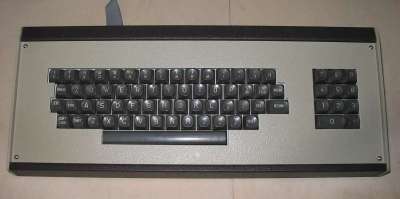 Alphanumeric and numeric keyboard built into its metallic case - LX.387-B and LX.549 |
|
Other LX.387 images (thanks to Piero Andreini):
|
It's an alphanumeric keyboard with good quality Cherry keys. The output is parallel so this keyboard can be connected to it's specific interface only by way of a 20 ways flat cable, and in particular to the video card LX.388 or to the video graphic card LX.529
Besides keys, on the card there is a KR.2376-ST chip only, that makes key scan and returns the corresponding 8 bit ASCII output code.
Initially they made a black keys keyboard code LX.387, and next they made a more low profile gray keys keyboard code LX.387-B, to witch it was possible to connect the numeric keyboard LX.549, that can be put in a proper beige metallic case.
Published on magazine number: 89
It's a numeric keyboard with good quality Cherry keys, that can be connected to the alphanumeric keyboard LX.387-B (the version with gray keys).
Both the alphanumeric keyboard LX.387-B and the numeric keyboard can be put in a proper beige metallic case.
FLOPPY DISK INTERFACE - LX.390
Published on magazine number: 75
Errata corrige on magazine number: 76
Printed circuit (gerber files): see printed circuit board section
This card is a floppy disk interface that permits the connection of maximum 4 drives.
The controller is a Western Digital FD1771, that is used on Tandy TRS-80 model 1 also, with FM coding.
Onboard there is an eprom with the needed firmware, and also a reset circuit.
Even if the eprom firmware doesn't need to be necessarily used in place of the monitor firmware on the CPU card, to use NE-DOS (due to minimum ram requirements) it's necessary to disable the eprom on the CPU card (as explained in the configurations section ), and consequently loose the possibility to use the hexadecimal keyboard. Anyway, in the add-ons and researches section there are explanations about patches that have to be done to use the hexadecimal keyboard and CPU card firmware together with this floppy disk interface and NE-DOS.
IMPORTANT NOTE: the eproms used on this card must have all bytes complemented at 1 (that is they must have all inverted bits). This because line-drivers used on this card data bus are 74LS240 chips, that contain inverters inside (this project choice was because the FD1771 controller has the inverted data bus). So, if you wish to write some personalized firmware in the eprom to be used on this card, be sure to complement the eprom content before to program it.
This eprom firmware is mapped starting from 0xF000 and must take control of the machine at startup. For this reason on this card there is a reset circuit to force the CPU to read the first three locations of this eprom in a similar manner as done by the reset circuit on the CPU card. But in this case, due to the fact that at reset the CPU starts reading from address 0x0000 that is put on the address bus, it's necessary to find a manner so that any cards mapped at this address don't send any data creating any conflict with the eprom.
The reset circuit on this card takes care of it: when the reset signal goes low (enabled), it enables the eprom to return data on the data bus, and at the same time it disables the ENH line on the bus so that all other cards are inhibited to send any data. This situation remains until the CPU executes a IN or OUT instruction on addresses D4, D5 or D6: infact any I/O on one of this addresses has the effect to activate Y2 output of IC13 (pin 10) on the floppy-disk card, making a permanent change to the state of the flip-flop that forces the eprom enable and the disable of other cards (until the next reset).
So, even if on the address bus the CPU put 0x0000, 0x0001 and 0x0002, on the data bus it see bytes from the eprom mapped at 0xF000, 0xF001 and 0xF002. These three bytes are a jump instruction like C3 F0 F3 (for the "1390" eprom, the "2390" eprom has C3 FD F3) so the CPU makes a jump to the address 0xF3F0, that is a location in the same eprom. At this time the CPU executes the instruction "DB D6" that means "IN A,(D6)" (that's for the "1390" eprom, in the "2390" eprom it's "D3 D6" that means "OUT (D6),A") and the reset circuit stop forcing the eprom enable and also enables the ENH line on bus leaving the CPU to continue operations normally.
The drives type used with this card are Tandon TM100-1, or BASF HP3, both 5" 1/4 single side single density.
It's possible to connect a maximum of 4 drives by using a 34 ways flat cable. All drives are connected in parallel (a bit different from PC connection where A drive has 4 wires swapped).
Obviously any drives need to be correctly addressed by setting jumpers on the drive, as explained in the article INTERFACCIA PER FLOPPY-DISK published on magazine number 75, in the article QUELLO CHE OCCORRE SAPERE SUI FLOPPY-DISK published on the magazine number 76, and in the article DRIVE E STAMPANTI published on the magazine number 86-87.
Additionally, in the add-ons and researches section there are explanations about how to connect standard 3" 1/2 floppy drives, in alternative or in addition to 5" 1/4 drives (always with the limit of 4 drives maximum).
This card is supported by floppy basic 1.0 with NE-DOS 1.0, by floppy basic 2.1 with NE-DOS 1.5, by floppy basic G.1.0 with NE-DOS G.1, or by SONE operative system.
Depending on used version it's necessary to change the eprom on the card, and in particular to plug a 2708 eprom code "1390" for NE.DOS 1.0 or 1.5, a 2708 eprom code "2390" for NE-DOS G.1, or a 2716 eprom code "683" for SONE.
This makes impossible to boot alternatively with an operative system of with another one (note that basic 1.0+NE-DOS 1.0 and basic 2.1+NE-DOS 1.5 support the video card LX.388 only, while basic G.1.0+NE-DOS G.1 and SONE support the video graphic card LX.529 only).
Anyway in the add-ons and researches section there are explanations about how to boot with an operative system or another one without changing eproms, or how to build a card with an ad-hoc eprom that lets you have a multi-boot and multi-firmware system.
Originally the floppy interface kit was sold with an eprom code "390" and a floppy disk containing the 5.5 KBytes basic. This basic and its related eprom were immediatly dismissed to have another formatting system and to have NE-DOS, and the eprom has been changed with another one that has code "1390".
The floppy with basic 1.0 and NE-DOS 1.0 is missing: if you have any informations or if you own them please e-mail me.
FLOPPY DISK OR HARD DISK POWER SUPPLY - LX.391
Published on magazine number: 76
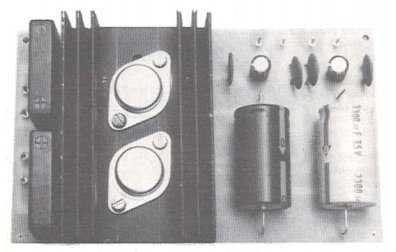 Floppy disk or hard disk power supply - LX.391 |
||
|
||
It's a linear stabilized power supply (not a switching one) that gives the following voltages:
This power supply is used to feed the floppy drives, or the hard-disk.
Published on magazine number: 75
Errata corrige on magazine number: 76
Printed circuit (gerber files): see printed circuit board section
It's an eprom programmer made by an interface card to be plugged on the bus card, a main card with a textool socket where to plug eproms to be programmed, a set of little cards that permit to choose the type of eprom to program, that have to be plugged into a proper connector on the main card, and a separated power supply.
The programmer can program eproms of types 2508, 2708, 2516, 2716 e 2532.
The eprom to be programmed is mapped in the CPU address space from address 0x9000 to 0x9FFF, so it's not possibile to use ram expansion cards mapped in the same address space. Additionally the card has a dedicated firmware on eprom mapped from 0x8400 to 0x8FFF, so also this address block is reserved and can't be used by any ram expansions.
The eprom programmer is supported by the hexadecimal keyboard and related interface only, and it requires at least 5 KBytes installed ram.
Published on magazine number: 101-102
Errata corrige on magazine number: 104-105
Printed circuit (gerber files): see printed circuit board section
|
||
|
||
It's a 12 megabytes hard-disk interface. The hard disk is a BASF 6188/F.
Even if on the magazine it's not said, the BASF 6188 hard-disk should have a ST-412 standard interface. The problem is that this hard-disk was sold by Nuova Elettronica together with a custom add-on controller card already attached to the hard-disk, so the LX.683 interface card doesn't implement ST-412 standard but it connects to this add-on controller that interfaces to the hard-disk. Obviously this custom add-on controller today is unavailable: if someone has any kind of informations please e-mail me.
UPDATE: luckily I got a Motorola MVME system that, as per the included documentation, uses a BASF 6188 hard-disk: incredibly there is also an add-on controller. The Motorola system has a very complete documentation, including schematics, and there is also an example circuit to connect the controller to a Z80 system. Well, I compared this circuit schematic with LX.683 interface and they are almost identical !!!!
So I discovered that the controller is a XEBEC S1410A, and that the interface is SASI standard (that is the predecessor of SCSI).
So, even if I can't be 100% sure, there are very strong possibilities that the original controller was that XEBEC, even because the two available controller photos on the magazine are 100% equals to the real XEBEC controller I got (also the printed circuit board tracks are identical). Also, I was able to build a LX.683 prototype interface and make the hard-disk to work without any changes.
More informations and some photos are available into the add-ons and researches section.
In order to use this card it's necessary to replace the eprom on the floppy-disk interface card LX.390 with an eprom code "EP.683". Additionally it's necessary to make some patches to the same card because this new eprom is a 2716 type, while the original eprom on the floppy interface card is a 2708 type.
The hard-disk interface is supported by SONE operative system only, that basically is a "renamed" CP/M, so by using this card it's not possibile to use NE-DOS and related basics, neither 16 KBytes basic, 5.5 KBytes basic or hexadecimal keyboard.
Published on magazine number: 72
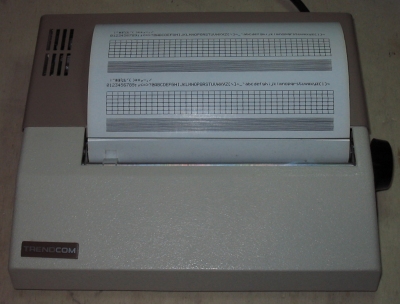 80 columns Trendcom 200 thermal printer with self-test page |
|
 Self-test page |
|
It's a thermal printer with standard Centronics parallel interface (but a non-standard connector) made by TRENDCOM, that can be connected directly to the printer interface LX.389 or to the video graphic interface LX.529 (to the printer port), after building the proper cable as explained on the magazine.
Two printers were available, Trendcom 100 with 40 columns text and Trendcom 200 with 80 columns text.
Trendcom 100 printer is missing: if you have any informations or if you own it please e-mail me.
12" VIDEO MONITOR AND METALLIC CASE
Published on magazine number: 73
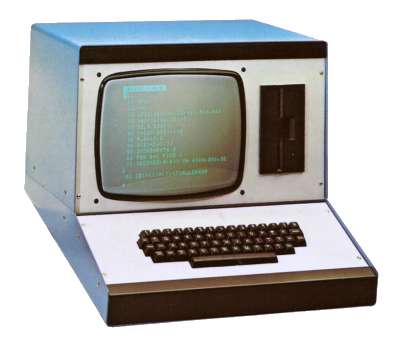 |
| Video monitor built into its metallic case with integrated keyboard and floppy drive |
It's a white phosphor 12" video monitor (it was also available a green phosphor version, at an additional cost), that had to be built into its light-blue and white metallic case, together with the alphanumeric keyboard LX.387 and a floppy drive.
It was sold already build, and it was necessary to put it in the case only.
This monitor and its case are missing: if you have any informations or if you own it please e-mail me.
Published on magazine number: 80
| Video monitor in its beige metallic case - LX.599 |
It's a green phosphors 12" video monitor built into a beige metallic case. Next to this monitor they published a similar case to contain floppy disk drives and another one to contain the alphanumeric keyboard LX.387-B (gray keys version) and the numeric keyboard LX.549.
It was sold already built and calibrated.
Published on magazine number: 89
It's a little card to be plugged in the A connector of the BUS card. This card uses the 50 Hz frequency coming from power supply 10 volt AC to generate a non maskable interrupt every 20 milliseconds.
This interrupt is used by NE-DOS to advance system time and to enable particular functions like for example the TRACE at DOS level.
Published on magazine number: 103
It's a little card to be connected to the alphanumeric keyboard LX.387 or LX.387-B, that enables auto-repeat and that makes a "click" (or a "beep") sound for every key pressed.
Besides the "click" or "beep" sound, it's useful only if you don't use NE-DOS that has built-in software auto-repeat.
Published on magazine number: 76 - rack case / desk
It's a black rack case that can contain all computer boards and power supply. There was a desk with wheels also to put in the rack case and the blue case with monitor and keyboard.
12" VIDEO MONITOR AND METALLIC CASE COVER
Published on magazine number: never published
It's a cover for 12" video monitor and metallic case. Probably it's the only piece actually existing: only 10 pieces were made, and only one was sold to Constantinos Haritakis, Nuova Elettronica collaborator, that recently found it.
It was never published on the magazine.